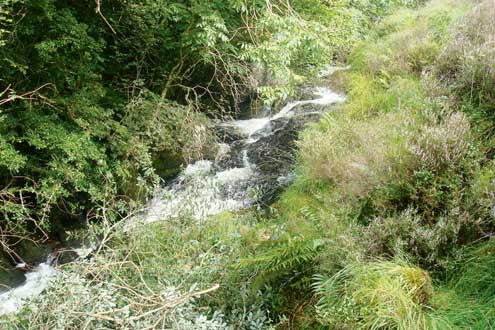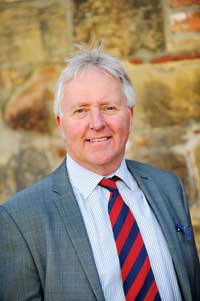Farmer goes for hydro in Snowdonia National Park

A hill farm in Wales is set to produce enough energy to power 300 households a year, thanks to a £1.3m investment in hydro power.
Gary Markham, who farms organic sheep and beef on the 570ha Cadair Idris estate in Gwynedd in partnership with his brother, had been unable to even graze sheep on parts of his land because it is so mountainous.
But the steep landscape, which the Afon Cadair river flows down, was identified as a potential site for hydro-electricity generation by independent developer and consultant engineer Jonathan Bensted, who approached Mr Markham in 2008 with an idea to develop a power generation scheme.
After being convinced a hydro scheme could fit in with the fragile environment of the peak of Cadir Idris, a site of special scientific interest (SSSI) in the heart of the Snowdonia National Park, Mr Markham agreed that land across his farm and that of his neighbour’s could be an ideal place to host the 300kW project.
| Tips |
|---|
|
“The farm is in a Tir Gofal agri-environment scheme and we are keen to manage the farm in an environmentally sympathetic way, so I was wary about whether it would fit in with the area,” he says.
“Renewable energy was a fairly new concept in 2008 and we didn’t have the Feed-in Tariff, but Jonathan convinced me that together we could do it right.”
Keen to limit any risk to the existing farm business, Mr Markham, who also works as an accountant, and Mr Bensted set up Dragon Hydro, a limited company that would run the project separately.
“I took on the shareholding of 50% with Mr Bensted which, depending on the intended size of a scheme, is a very important move farmers should make,” says Mr Markham (see box below).
Admitting it was a leap of faith, the pair spent about £70,000 on engineering consultations and environmental reports to ensure the scheme was feasible and could pass strict planning regulations.
“The reports seemed never-ending,” Mr Markham says. “We have had to jump through hoops as we are under scrutiny from Snowdonia National Parks to make sure we do everything correctly.
| Hydropower: |
|---|
More information and advice: Gary Markham at Dragon Hydro: info@dragonhydro.com |
“It can weigh you down. You’re spending money for assessments and reports and as you’re writing the cheques, you’re wondering when the hurdle you can´t get over is going to appear.”
Despite the long process, Mr Markham admits it was not as difficult as it could have been because he established a good relationship with the planners.
“From the outset we asked the planners what we needed to do. They key is to have the right attitude and realise they have a job to protect the environment.”
In addition to the environmental aspects, the engineering behind such a scheme is incredibly complex too, Mr Markham adds.
“You can’t just put a single pipe from the water to the turbine, they have to be different sizes at different points. It requires detailed and complicated calculations.
“The intake is upstream, up the mountain, then the pipe runs underground for 2.4km down to a 5m x 8m powerhouse, which is built of local, natural stone to comply with planning regulations.”
It is also vital to ensure from the outset that it is possible to connect to the National Grid so that you can sell power, he adds.
“The grid in the mountains is mostly not up to taking the electricity from the generator, but you have to have a connection to sell your power.
“We ended up paying Scottish Power more than £100,000 to get connected, but if you can’t get connection to the grid without it costing you £200,000 or £300,000, then you might as well not bother with the project.”
Once grid connection was established – a step that can take between six and nine months – Mr Markham and Jonathan’s next hurdle was to find a way to fund the scheme.
“You can actually sell the scheme at that stage and you would get a little more than you spent, because you’re selling the scheme’s potential,” Mr Markham says.
“But that extra wouldn’t recompense you for the pain of going through the planning, so we approached venture capitalists Albion Ventures for the investment (see panel, left).”
With the funding, planning permission and agreements with neighbours in place, Mr Markham and Jonathan have now hired a contractor and a project manager.
Bespoke technology, which is built specifically for the site’s gradients and water intake, is being imported from the USA and they hope to have the system on-line by August 2013.
“I didn’t realise it was so complicated and it’s not for the faint-hearted,” says Mr Markham. “But as long as you get the engineering right, and with the FiT in place, it is a profitable scheme. We would definitely be interested in investing in other projects.”
| Managing and funding a hydro scheme |
|---|
 Mr Markham decided to run his farm’s hydro scheme separately through a limited company to minimise risk to his family farm. Mr Markham decided to run his farm’s hydro scheme separately through a limited company to minimise risk to his family farm. But depending on the size of the scheme, they can be funded through the farm business. “A small scheme that costs anything from £40,000 to £100,000 should be OK to be funded through the farm, if the farm can handle the risk,” says Mr Markham. “However, anything above that and you should really form a limited company.” Securing investment for a larger project can be a hurdle, as most farmers would automatically approach banks, which are not necessarily the best option. “Banks are interested in renewable energy schemes, but the only way they will deliver on larger projects like this is if they can take the deeds of the farm and the farm can fund the borrowing. For me, that was too risky,” Mr Markham says. Instead, he approached venture capitalists, securing a £1.3m investment from Albion Ventures – which has already invested £22m across several renewable schemes across the country – in exchange for a share of his company Dragon Hydro. “Giving away equity is really the only way to get investment,” he says. “We negotiated a deal so the business is split roughly three ways between Jonathan, Albion and myself, but each deal is different, so it’s worth paying for an expert advisor. “Typically, shareholding would be 50% or more on the part of the venture capitalists, as they will want control to ensure a good return on their investment. “Sometimes they may even demand 100% ownership, and then as their investment gets repaid they hand back shares.” Once electricity is being produced, in addition to receiving a FiT, it can either be sold in long-term, 10-year contracts – which many investors may demand for security – or on the spot market. “Many venture capitalists will actually want to get out in five years, so you need to structure a repayment plan that works for all of you,” Mr Markham says. “After five years you could go to the bank for refinancing because the bank will be happier to give funding as there is less risk in an established scheme. Alternatively you could sell the project as a working scheme.” |
